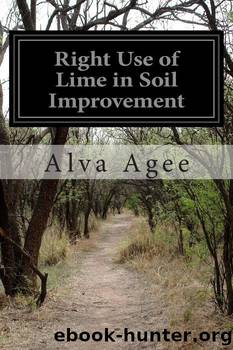Right Use of Lime in Soil Improvement by Alva Agee

Author:Alva Agee [Agee, Alva]
Language: eng
Format: epub
ISBN: 9781499637601
Barnesnoble:
Publisher: CreateSpace Publishing
Published: 2014-05-22T00:00:00+00:00
Laying Foundation for a Lime Stack at the Pennsylvania Experiment Station Laying Foundation for a Lime Stack at the Pennsylvania Experiment Station
A Stack Nearly Completed at the Pennsylvania Experiment Station A Stack Nearly Completed at the Pennsylvania Experiment Station
* * *
CHAPTER XI
BURNING LIME
Methods of Burning. Limestone contains the calcium and magnesium that must be the chief source of supply of American soils, though marls, ashes, etc., have their place. The burning of the stone has been the leading means of bringing it to a condition of availability to the soil, excepting, of course, the vast work of disintegration carried on through all the ages by nature. Pulverization of the rock by machinery for use on land is recent.
The devices for burning are various, a modern lime plant containing immense kilns, cylindrical in form, the stone being fed into them at the top continuously, and the lime removed at the bottom. A large part of the lime that is sold for use on land is made in plants of this kind. Some is burned in kilns of cheap construction, but a traveler through a limestone country finds few such kilns now in use.
The Farm Lime Heap. A common method of producing lime for farm use has been, and continues to be, a simple and inexpensive one, involving the use only of wood, coal and limestone, with earth as a covering. Dr. Wm. Frear, chemist of the Pennsylvania station, in Bulletin 261 of the Pennsylvania department of agriculture, describes a method of burning lime on the farm as follows: "A convenient oblong piece of ground is cleared, and leveled if need be, to secure a fit platform. Upon this level is placed a layer or two of good cord wood, better well seasoned, arranged in such manner as to afford horizontal draught passages into the interior of the heap. Between the chinks in the cord wood, shavings, straw or other light kindling is placed. The stone having been reduced to the size of a double fist, sometimes not so small, is laid upon the cord wood, care being taken to leave chinks between the stones just as between the bricks in a brick kiln. It is preferred that this layer of stone should not exceed six to ten inches in thickness.
"In some cases, temporary wooden flues, filled with straw, are erected, either one at the center or, if the heap is elliptical, one near each end, and the stone and coal are built up around them; thus, when they are burned out, a chimney or two is secured, which may be damped by pieces of stone or sod. Upon this first layer of stone is spread a layer of coal, and upon that a thicker layer of stone (12 inches), and so on, coal and stone alternating until the heap is topped with smaller stone. The largest stones should be placed near the top of the heap, but not near the outside, so that they may be exposed to the highest heat.
Download
This site does not store any files on its server. We only index and link to content provided by other sites. Please contact the content providers to delete copyright contents if any and email us, we'll remove relevant links or contents immediately.
The Permaculture Way by Graham Bell(523)
The Permaculture Garden by Graham Bell(452)
People & Permaculture by Looby Macnamara(411)
The Complete Guide to GROWING YOUR HOPS, MALTS, AND BREWING HERBS: EVERYTHING You Need to Know Explained Simply by John Peragine(359)
The New Seed-Starters Handbook by Nancy Bubel & Jean Nick(347)
GMOs Decoded by Sheldon Krimsky(298)
Sowing Seeds of Change: Informing Public Policy in the Economic Research Service of USDA by Panel to Study the Research Program of the Economic Research Service(181)
The Stewardship of the Soil by John H. (John Henry) Worst(21)
Manures and the principles of manuring by Charles Morton Aikman(17)
Diffusion and transfer of knowledge in agriculture by Christian Huyghe Pascal Bergeret Uno Svedin(14)
Right Use of Lime in Soil Improvement by Alva Agee(12)
